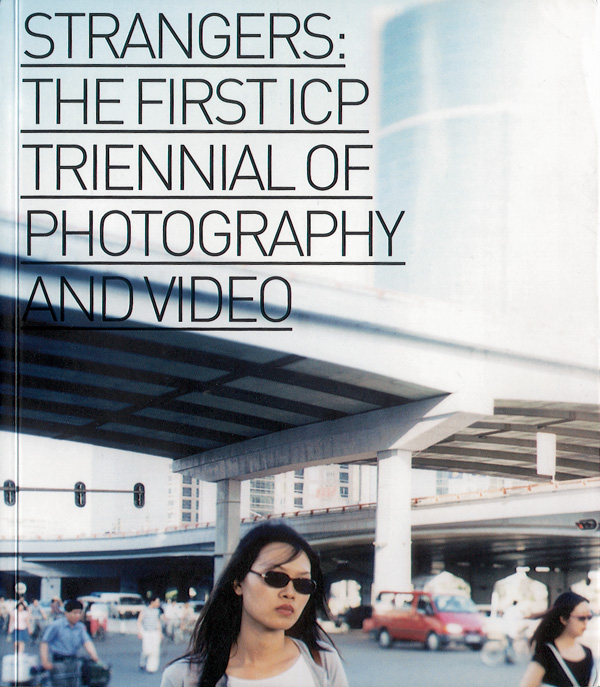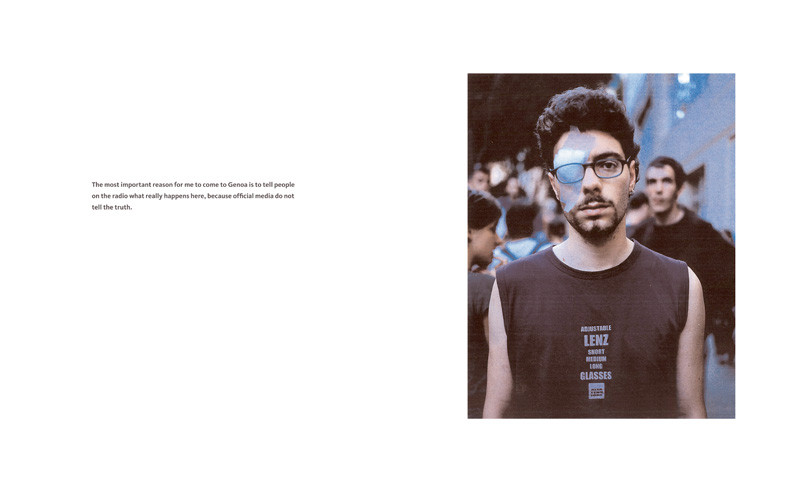[Spring 2004]
Earle, Edward W., et al., eds.
(New York: International Center for Photography and Göttigen: Steidl Publishers, 2003).
ICP Exhibition dates:
12 September–30 November 2003.
The International Center for Photography offered its first foray into the proliferation of international art festivals with its recent exhibition, Strangers. It is somewhat surprising that New York does not already host a recurring art event devoted to contemporary photography, considering the number of practitioners, dealers, curators, and institutions located in the city and its environs. ICP intends to redress this curatorial omission through an ambitious and ongoing critical assessment of current practices in the development of the medium. Moreover, in questioning whether the New York gallery scene had become too insular over the past decade, ICP senior curator Christopher Phillips and his colleagues, Edward W. Earle, Carol Squiers, and Brian Wallis, saw the creation of ICP’s triennial exhibition as an opportunity to provide viewers with some sense of the diverse interrogations taking place in photography around the globe.
The curatorial team chose the open-ended concept of “strangers” as the starting point for its critical investigations. This state of being rendered alien, foreign, or in opposition to those around one has been the source for photographic explorations since the inception of the medium, whether in the ongoing documentary practices of street photographers or metaphorically in reference to the desire of the photographer to prompt the viewer into seeing even the altogether familiar in a new light. Thus, beginning in the broadest strokes, with work in which a photographer deliberately engages with the unknown or unfamiliar, the curators became more and more intrigued by the widely divergent approaches to what they construed as basic, almost universal questions about belonging, alienation, engagement, communication, and interaction, and they found examples ranging from the commonplace to the extraordinary. Underlying the explorations of stranger-as-subject is a renewed appreciation for the photographic strategy of using a repetitive format or grid to call difference into question through explicit anomalies manifested through this design.
Accompanying the exhibition is a lavishly illustrated catalogue, bringing together essays by each of the four ICP curators, illustrative texts for each of the invited artists, and early writing on the notion of strangers by authors such as Walter Benjamin and Julia Kristeva. In the introductory text entitled “The Stranger,” Carol Squiers provides a historical context for the stranger within photography, citing nineteenth-century examples as well as early twentieth-century reportage, and traces the apparition through to recent work presented in the exhibition. In his essay entitled “The Use of Strangers,” Christopher Phillips explores the notion of the encounter, our fascination with the anonymous stranger, and the slippages between private and public implied by in such meetings. Brian Wallis’s text entitled “Ethnographies of Everyday Life” looks to Frantz Fanon’s explorations of identity and the psychological interpretations of the stranger as a means to examine our current preoccupations with territory and belonging, and ultimately the corresponding situation of not belonging. Wallis introduces a discussion of language and translation as means to be understood and to understand, but nonetheless admits to the impossibility of verisimilitude. Finally, in “A House with Open Windows” Edward W. Earle posits questions about the future directions in which photographers and video practitioners might explore the notion of strangers, in relation to new technologies and to the Web, within which anyone can adopt the role of stranger of his or her own devising. Rather than seeing new technologies as intruders in the house of photography – as strangers, in fact – Earle proposes that they be greeted as friends and opportunities for renewal.
Strangers encompasses over a hundred examples of recent work in photography and video by forty international artists, including regular players on the festival circuit such as Rineke Dijkstra, Philip-Lorca di Corcia, Shirin Neshat, Krzysztof Wodiczko, and Joel Sternfeld. One of the more interesting approached to the exhibition’s theme is a series of photographs entitled “Dear Stranger” (1998–2000) by Shizuka Yokomizo, a Japanese artist based in England. The series is composed of anonymous portrait encounters between the photographer and random individuals residing in London, Berlin, Tokyo, and New York. Yokomizo selected her subjects based on their shared circumstance of residing in easily accessible ground-floor apartments. All was contacted through a polite, anonymous letter, requesting that if they chose to participate in the portrait project, they were to stand in their open window at a prearranged time for a ten-minute period, during which Yokomizo would photograph them with a telephoto lens. They could indicate a refusal to interact with Yokomizo by simply keeping the curtains drawn at the appointed hour. There was no contact between the photographer and subject other than the tacit agreement to act as beholder and beheld. The photographs in Yokomizo’s series follow a strict compositional arrangement – subject posed frontally in the centre of the image lit from behind – but structure is where the similarities end. What is fascinating to observe are the subject’s highly individualized responses to the encounter, whether shyly hesitant or pushing the boundaries toward exhibitionism.
Rineke Dijkstra’s photo series entitled Almerisa (1994–2002) presents the viewer with a chronicle of portraits showing the transition of a young girl into adolescence over an eight-year period. Almerisa went to Holland with her family as refugees from Bosnia, and Dijkstra photographed the girl in two-year intervals starting shortly after her arrival. Employing a static portrait format that hovers somewhere between intimate encounter and anthropological investigation, Dijkstra deftly underscores emerging traces of Almerisa’s adult persona through the changes in her physical appearance, clothing, and posture. She poses questions about how subjectivity is developed, and how comfortable or uncomfortable one person can be in his or her own skin through different stages of life.
Coco Fusco’s Els Segadors (The reapers) (2001), one of the video works in the exhibition, examines strangers from within shared territorial borders, through the problematics of culture and language. Following the Spanish Civil War and Franco’s rise to power, public use of the Catalan language and other cultural displays were outlawed. These restrictions were lifted only as recently as the 1980s, and today, in complete contradiction to the early prohibitions, those who cannot speak Catalan find themselves economically and socially at a distinct disadvantage. Fusco invited participants be filmed while singing the Catalan national anthem, documenting not only the disparate renditions, but also a discussion about the individual person’s heritage and relationship to the language. Some of the sessions point to the penetration of omnipresent cultural influences, such as the rap interpretation of the folk song, while others are tinged with the frustrating repercussions of assimilation, as evidenced in the story of a Catalan woman who grew up speaking Spanish and now speaks her native language in the heavily accented tones normally associated with a foreigner.
Joel Sternfeld’s photo essay entitled Treading on Kings, Protesting the G-8 in Genoa (2001) takes issue with the mainstream media’s customary characterizations of political demonstrations as a homogeneous throng. Juxtaposing individual portraits of protestors with excerpts of interviews with the subjects, Sternfeld presents the viewer with a cross section of people from all over the globe, who may share a political ideology, but likewise have equally important personal reasons for taking part in the protest. The portraits represent the coming together of strangers in a united front, yet the subjects ultimately retain their independent voices.
The exhibition represents a strong start to this new chapter in ICP’s programming, largely due to the fact that the chosen theme provides for such widely varied responses in photography and video to timely issues in contemporary society. In addition, Strangers respects the long-established aims of ICP to critically engage with the traditions of photojournalism while enabling the curators to respond to work that might previously have been considered outside of their mandate. Will the next topic of investigation be as noteworthy, and, more important, will the centre be able to surpass the critical and creative benchmark set with this exhibition? We’ll have to wait three years to find out.



